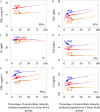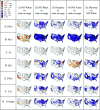Disparities in Air Pollution Exposure in the United States by Race/Ethnicity and Income, 1990-2010
- PMID: 34908495
- PMCID: PMC8672803
- DOI: 10.1289/EHP8584
Disparities in Air Pollution Exposure in the United States by Race/Ethnicity and Income, 1990-2010
Abstract
Background: Few studies have investigated air pollution exposure disparities by race/ethnicity and income across criteria air pollutants, locations, or time.
Objective: The objective of this study was to quantify exposure disparities by race/ethnicity and income throughout the contiguous United States for six criteria air pollutants, during the period 1990 to 2010.
Methods: We quantified exposure disparities among racial/ethnic groups (non-Hispanic White, non-Hispanic Black, Hispanic (any race), non-Hispanic Asian) and by income for multiple spatial units (contiguous United States, states, urban vs. rural areas) and years (1990, 2000, 2010) for carbon monoxide (CO), nitrogen dioxide (), ozone (), particulate matter with aerodynamic diameter (; excluding year-1990), particulate matter with aerodynamic diameter (), and sulfur dioxide (). We used census data for demographic information and a national empirical model for ambient air pollution levels.
Results: For all years and pollutants, the racial/ethnic group with the highest national average exposure was a racial/ethnic minority group. In 2010, the disparity between the racial/ethnic group with the highest vs. lowest national-average exposure was largest for [54% ()], smallest for [3.6% ()], and intermediate for the remaining pollutants (13%-19%). The disparities varied by U.S. state; for example, for in 2010, exposures were at least 5% higher than average in 63% of states for non-Hispanic Black populations; in 33% and 26% of states for Hispanic and for non-Hispanic Asian populations, respectively; and in no states for non-Hispanic White populations. Absolute exposure disparities were larger among racial/ethnic groups than among income categories (range among pollutants: between 1.1 and 21 times larger). Over the period studied, national absolute racial/ethnic exposure disparities declined by between 35% (; ) and 88% (; CO); relative disparities declined to between (; i.e., nearly zero change) and (CO; i.e., a reduction).
Discussion: As air pollution concentrations declined during the period 1990 to 2010, absolute (and to a lesser extent, relative) racial/ethnic exposure disparities also declined. However, in 2010, racial/ethnic exposure disparities remained across income levels, in urban and rural areas, and in all states, for multiple pollutants. https://doi.org/10.1289/EHP8584.
Figures




Comment in
-
Invited Perspective: Moving from Characterizing to Addressing Racial/Ethnic Disparities in Air Pollution Exposure.Environ Health Perspect. 2021 Dec;129(12):121302. doi: 10.1289/EHP10076. Epub 2021 Dec 15. Environ Health Perspect. 2021. PMID: 34908494 Free PMC article. No abstract available.
References
-
- Abel TD, Salazar DJ, Robert P. 2015. States of environmental justice: redistributive politics across the United States, 1993–2004. Rev Policy Res 32(2):200–225, 10.1111/ropr.12119. - DOI
Publication types
MeSH terms
Substances
Grants and funding
LinkOut - more resources
Full Text Sources
Medical
Research Materials

